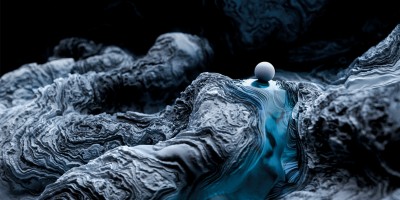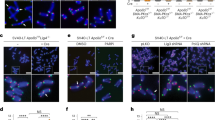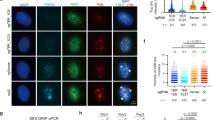Abstract
The response to DNA damage involves regulation of several essential processes to maximize the accuracy of DNA damage repair and cell survival1. Telomerase has the potential to interfere with repair by inappropriately adding telomeres to DNA breaks. It was unknown whether cells modulate telomerase in response to DNA damage to increase the accuracy of repair. Here, we report that telomerase action is regulated as a part of the cellular response to DNA double-strand breaks (DSBs). Using yeast, we show that the main ATR/Mec1 DNA damage signalling pathway regulates telomerase action at DSBs. After DNA damage, MEC1–RAD53–DUN1-dependent phosphorylation of the telomerase inhibitor Pif1 occurs. Using a separation of function PIF1 mutation, we show that this phosphorylation is specifically required for the Pif1-mediated telomerase inhibition that takes place at DNA breaks, but not for that at telomeres. Hence DNA damage signalling down-modulates telomerase action at DNA breaks through Pif1 phosphorylation, thus preventing aberrant healing of broken DNA ends by telomerase. These findings uncover a new regulatory mechanism that coordinates competing DNA end-processing activities and thereby promotes DNA repair accuracy and genome integrity.


Similar content being viewed by others
References
Harper, J. W. & Elledge, S. J. Mol. Cell 28, 739–745 (2007).
Myung, K., Datta, A. & Kolodner, R. D. Cell 104, 397–408 (2001).
Diede, S. J. & Gottschling, D. E. Cell 99, 723–733 (1999).
Marcand, S., Brevet, V., Mann, C. & Gilson, E. Curr. Biol. 10, 487–490 (2000).
Myung, K., Chen, C. & Kolodner, R. D. Nature 411, 1073–1076 (2001).
Schulz, V. P. & Zakian, V. A. Cell. 76, 145–155 (1994).
Lasko, D., Cavenee, W. & Nordenskjold, M. Annu. Rev. Genet. 25, 281–314 (1991).
Wilkie, A. O., Lamb, J., Harris, P. C., Finney, R. D. & Higgs, D. R. Nature 346, 868–871 (1990).
Lahaye, A., Stahl, H., Thines-Sempoux, D. & Foury, F. EMBO J. 10, 997–1007 (1991).
Zhao, X., Muller, E. G. & Rothstein, R. Mol. Cell 2, 329–340 (1998).
Zhao, X. & Rothstein, R. Proc. Natl Acad. Sci. USA 99, 3746–3751 (2002).
Wagner, M., Price, G. & Rothstein, R. Genetics 174, 555–573 Epub 2006 Jul 2002. (2006).
Bessler, J. B., Torredagger, J. Z. & Zakian, V. A. Trends Cell Biol. 11, 60–65 (2001).
Uchiki, T., Dice, L. T., Hettich, R. L. & Dealwis, C. J. Biol. Chem. 279, 11293–11303 (2004).
Sun, Z., Fay, D. S., Marini, F., Foiani, M. & Stern, D. F. Genes Dev. 10, 395–406 (1996).
Snow, B. E. et al. Mol. Cell. Biol. 27, 1017–1026 (2007).
Makovets, S., Herskowitz, I. & Blackburn, E. H. Anatomy and dynamics of DNA replication fork movement in yeast telomeric regions. Mol. Cell. Biol. 24, 4019–4031 (2004).
Herskowitz, I. & Jensen, R. E. Putting the HO gene to work: practical uses for mating-type switching. Methods Enzymol. 194, 132–146 (1991).
O'Rourke, S. M. & Herskowitz, I. The Hog1 MAPK prevents cross talk between the HOG and pheromone response MAPK pathways in Saccharomyces cerevisiae. Genes Dev. 12, 2874–2886 (1998).
Fisher, T. S., Taggart, A. K. & Zakian, V. A. Cell cycle-dependent regulation of yeast telomerase by Ku. Nature Struct. Mol. Biol. 11, 1198–1205 (2004).
Acknowledgements
We thank members of the Blackburn and Harrington laboratories for encouraging discussions and useful ideas. We also thank C. Anderson for pEHB13045 and H. Interthal and N. E. Murray for critical reading of the manuscript and helpful suggestions. We thank the laboratory of L. A. Harrington for support of S.M. since February 2008 (with funds provided by the School of Biological Sciences, University of Edinburgh, and Wellcome Trust Programme Grant 84637 to L. A. Harrington). This work was supported by NIH grant GM26259 (to E.H.B.).
Author information
Authors and Affiliations
Contributions
S.M. designed and performed the experiments and analysed the data. S.M. and E.H.B. discussed results and wrote the manuscript.
Corresponding author
Ethics declarations
Competing interests
The authors declare no competing financial interests.
Supplementary information
Supplementary Information Figures and Tables
Supplementary Information (PDF 935 kb)
Rights and permissions
About this article
Cite this article
Makovets, S., Blackburn, E. DNA damage signalling prevents deleterious telomere addition at DNA breaks. Nat Cell Biol 11, 1383–1386 (2009). https://doi.org/10.1038/ncb1985
Received:
Accepted:
Published:
Issue Date:
DOI: https://doi.org/10.1038/ncb1985
- Springer Nature Limited
This article is cited by
-
Telomerase subunit Est2 marks internal sites that are prone to accumulate DNA damage
BMC Biology (2021)
-
Dynamic regulation of Pif1 acetylation is crucial to the maintenance of genome stability
Current Genetics (2021)
-
Fine tuning the level of the Cdc13 telomere-capping protein for maximal chromosome stability performance
Current Genetics (2019)
-
Telomerase regulation by the Pif1 helicase: a length-dependent effect?
Current Genetics (2018)
-
Rnr1’s role in telomere elongation cannot be replaced by Rnr3: a role beyond dNTPs?
Current Genetics (2018)





